Now, Once again, 'There is no TRIZ that doesn't work'
- As a core technology for solution -
Hajime Kasai (IDEA Inc.)
(English translation by the Japan TRIZ Society)
at Institute of Mathematical Statistics, Tachikawa, Tokyo
Now, Once again, 'There is no TRIZ that doesn't work' |
|
| Hajime Kasai (IDEA Inc.) |
|
| Presented at 9th TRIZ Symposium in Japan, Held on Sept. 5-6, 2013 at Institute of Mathematical Statistics, Tachikawa, Tokyo |
|
| [Posted: Dec. 9, 2013] |
For going back to Japanese pages, press buttons.
Editor's Note (Toru Nakagawa, Dec. 7, 2013)
This paper was presented last September at the TRIZ Symposium in Japan, 2013. This presentation has received the 'Best presentation for you' Award by the participants' voting and has been posted publicly in the Official Web site of the Japan TRIZ Society
(see also Nakagawa's Personal Report of Japan TRIZ Symposium 2013
). Evaluating this presentation highly, I am posting it in this "TRIZ Home Page in Japan" Web site, under the author's desire and permission and the JTS's permission.
"There is no TRIZ that doesn't work" is the motto of IDEA Inc. (CEO: Mamoru Zenko), which started as a consulting firm specialized in TRIZ in 2003 by spinning off from a TQM-based consulting company. As quoted in Slides #04 through #07, their approach with the motto was presented in September 2003 at the 4th Japan Invention Machine Users Group Conference (held by Mitsubishi Research Institute) by Hiroto Hayashi (currently IWEL) (its full presentation is posted in this site
). Since then IDEA has been promoting TRIZ actively, and the present author Mr. Hajime Kasai alone has experienced 119 cases of applying TRIZ to real projects. The author is disclosing his application methods after classifying them according to the types of problems.
For these several years, a number of (SME) industries presented at Japan TRIZ Symposia their successful case studies of applying TRIZ together with QFD and Taguchi Method. Several of them give acknowledgements to IDEA and Mr. Kasai, as careful readers may have recognized.
The paper describes that the methodology having TRIZ as its core has been successfully applied to different types of industrial requirements, including Problem solving, Performance improvement, New method identification, Cost reduction, Reduction in size and weight, and Product planning. The methodology uses various selected tools in TRIZ, and depending on the requirements uses QFD at the preceding stage and TM at the subsequent stage. Especially, for the 6 types of requirements mentioned above, the author has set up customized full processes by selecting suitable tools. The author calls such a full process of methodology as 'solution'.
The present paper coincides with my proposal of the 'General methodology of creative problem solving and task achieving (CrePS)'
in the following points:
(a) The above-mentioned 6 types of requirements form a part of the problems and tasks (in the sense of technical requirements in (manufacturing) industries) which are supposed in the CrePS methodology.
(b) The author uses 'TRIZ as the core method' for achieving such requirements; this means that the main part of CrePS (to be processed in the 'Thinking World') is essentially built already by TRIZ (including USIT etc.) in an effective way.
(c) At the pre- and post-TRIZ stages, the author uses some other relevant methods, e.g., QFD and TM. The processes need to be carried out in the 'Real World' at the initial and succeeding parts of CrePS, by using such relevant methods.
(d) The author recommends several sets of full processes (i.e., 'solutions') composed of tools selected for each type of requirements. They correspond to guidelines of the CrePS usage which shows recommended courses of processes; such a process uses a set of suitable tools selected from a variety of individual tools classified/positioned in a general/universal framework.
Note that USIT, which I am recommending as a concise and consistent process based on the CrePS methodology, is rather general and not so specific as Kasai's six 'solutions'. USIT is not limited to the 'problem solving' but covers all the 6 types of requirements mentioned above. This point is ensured by the process of understanding the ideal system in addition to the understanding of the present system. (However, to be powerful and best for each type of requirement, some tools other than the standard USIT techniques are of course necessary.)
| Top of the page | Abstract | Abstract PDF |
Slides | "Solutions" | 6 types of TRIZ application | Slides PDF |
JTS site |
Japan TRIZ Symp. Report (Nakagawa) |
CrePS Vision |
Japanese page |
Abstract (Submitted on May 15, 2013) PDF (in Japanese)
Now, Once again, 'There is no TRIZ that doesn't work'
- As a core technology for solution -Hajime Kasai (IDEA Inc.)
(English translation by the Japan TRIZ Society)9th TRIZ Symposium in Japan, held on Sept. 5-6, 2013 in Tokyo
Abstract
Since its establishment in 2003, with our motto of "TRIZ as a practical problem-solving methodology", IDEA has helped the Japanese manufacturing sector develop high-functionality and high-quality products in a timely and cost-effective manner. During the last ten years, the author has been engaged in many real -world product development and problem-solving projects of the company's clients as a TRIZ methodology consultant.
In the book published in 2006, the author proposed a series of TRIZ-based problem-solving processes to illustrate how engineers can apply TRIZ to solve various types of day-to-day problems. In addition, in this presentation, the author has classified 119 project themes that the author was engaged in for the last 10 years as a consultant into 6 project theme categories. The project details including their themes, processes and results are not sharable due to the non-disclosure nature; however, the author's intention in this presentation will discuss how TRIZ can be applied in each project-type category and also how TRIZ can be more effectively applied in specific types of projects, together with other systematic methodologies such as QFD and Taguchi Method.
The author hopes this report shall provide some useful guideline bases to TRIZ practitioners and researchers as to effective TRIZ applications.
Presentation Slides: Slides in PDF
(29 slides, 1.3 MB)
Slides in Japanese in HTML Slides in Japanese in PDF
1. Introduction

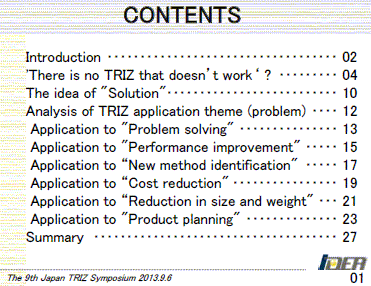


2. 'There is no TRIZ that doesn't work' ?

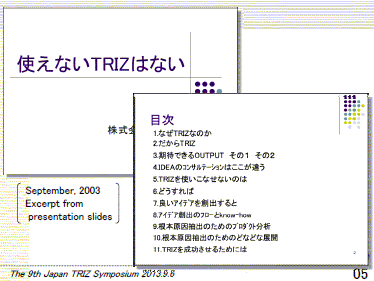


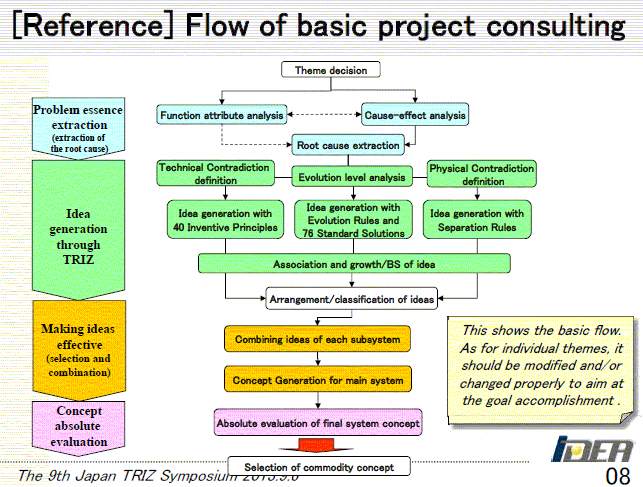

3. The idea of 'Solution'

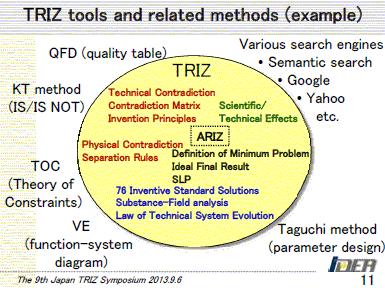
4. Analysis of TRIZ application theme (problem)
4.1 Application to "Problem solving"


4.2 Application to "Performance improvement"


4.3 Application to "New method identification"


4.4 Application to "Cost reduction"

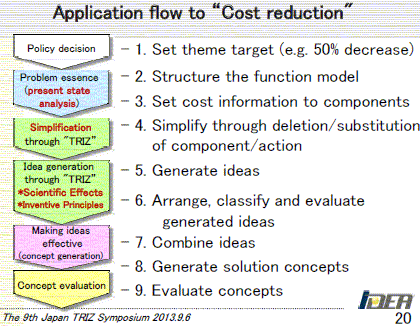
4.5 Application to "Reduction in size and weight"


4.6 Application to "Product planning"



4.7 Application flow summary
5. Summary


| Top of the page | Abstract | Abstract PDF |
Slides | "Solutions" | 6 types of TRIZ application | Slides PDF |
JTS site |
Japan TRIZ Symp. Report (Nakagawa) |
CrePS Vision |
Japanese page |
Last updated on Dec. 9, 2013. Access point: Editor: nakagawa@ogu.ac.jp